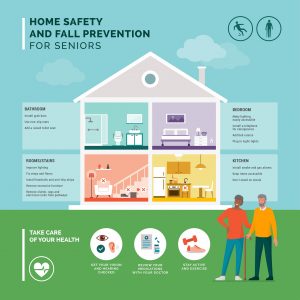As we age, our chance of suffering a fall increases, especially for people over age 65. If you have fallen in the past, your chances of falling again are doubled. For older adults, the risk of suffering an injury such as a broken hip, head injury, or other broken bone is approximately one in five.
Who is at Greatest Risk?

Women represent the greatest risk for falling and, as they age, are more likely to develop osteoporosis, a disease that weakens the bones, increasing the likelihood of breaks. While many falls do not cause injury, a staggering 3 million people are hospitalized each year for fall injuries. The most serious injury from a fall is a broken hip, typically resulting in falling sideways.
Recovering from a broken hip may be difficult for an older person and can lead to a loss of independence. Hip injuries can take a toll on a person physically, even after the hip has healed. It is important to inform your physician of any falls you have had in the past.
The Aftermath of Falling
While falling does not always result in serious injury, one in five falls causes injuries to the head or broken bones. This can cause a drastic change in a person’s ability to care for themselves or their ability to get around independently.
Head injuries in an older person can be extremely dangerous, especially if the person is on certain medicines like blood thinners, making them prone to bleeding easily. Anyone who falls and hits their head should immediately consult with their physician to ensure they did not suffer a brain injury.
Falling can also cause fear in people, resulting in them becoming less active and limiting their normal activities. When a person becomes less active, they also become weaker, which can increase their chances of falling.
Risk Factors to Falling
There are certain factors that can impact a person’s likelihood of falling. These risk factors include:
- Balance issues
- Use of certain medications like sedatives, antidepressants, or tranquilizers
- Problems with your vision
- Weakness of the lower body
- Vitamin D deficiency
- Dangers at home such as items that you can easily trip over
- Foot pain
You suffer a greater risk of falling if you have more than one risk factor, so it is important to speak with your doctor about any risk factors you may have.
What You Can Do to Avoid Falling

Your doctor can provide you with an evaluation and assess your risk for falling. Furthermore, your doctor can look over your prescribed medications to see if there are side effects of dizziness or sleepiness that could contribute to falling.
Some other things you can do at home to help prevent falling are:
- Make sure your home is well-lit
- De-clutter your home
- Add railings on both sides of your stairs
- Use non-slip mats in your shower and add grab bars in your bathtub
- Keep items in your kitchen where you can easily reach them
Exercise is also a crucial factor in helping prevent falls. Building muscle in your legs and lower body is a terrific way to prevent falling. There are exercise videos online that can be done at home and are tailored for every skill level.
The Cost of Falling
Each year, 800,000+ older adults are admitted to hospitals for fall-related injuries, with 300,000 treated for hip fractures. Traumatic brain injuries (TBI) are caused by falls and can lead to more serious problems if undetected or not treated. Each year, approximately $50 billion is spent on medical costs for injuries related to falling, with Medicare, Medicaid, and private insurance absorbing about 75% of that cost.
Not only are injuries from falls serious and can be life-altering, but they are also extremely expensive. If you feel you are at risk of falling or have fallen in the past, contact your physician and discuss a treatment plan that works for you.
Greater Waterbury Imaging Center is committed to your overall health and wellness. Our team of highly skilled, professional technologists works with you to provide the highest level of care. Contact us for all your MR imaging needs.


